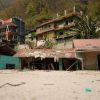Writer and Web page data
- This web page: https://www.globalissues.org/article/805/cop20-lima-climate-conference.
- To print all data (e.g. expanded facet notes, exhibits different hyperlinks), use the print model:
On this web page:
Introduction
 December 1 – 14, 2014, Lima, Peru was the venue for the twentieth annual United Nations Local weather Change Convention, also called the twentieth Convention of the Events — or COP 20.
December 1 – 14, 2014, Lima, Peru was the venue for the twentieth annual United Nations Local weather Change Convention, also called the twentieth Convention of the Events — or COP 20.
The aim of this convention was to create a common settlement on local weather change motion and start the method of financing mitigation.
Assembly end result
The assembly ended with all nations agreeing to chop again greenhouse fuel emissions. Generally known as the Lima Accord, this treaty just isn’t legally binding and international locations would not have to specify how a lot they’ll reduce, as an alternative agreeing to report their plans again by March 2015.
Whereas for a lot of it gave the impression of a profitable end result, others have been dissatisfied, resembling poor international locations struggling to rebuild from present impacts of local weather change who have been alarmed on the disappearance of loss and injury commitments from the ultimate textual content which has been a part of the dialogue for years.
The worldwide local weather motion, 350.org, summarized the disappointments and hopeful elements of the assembly end result, noting
- The brand new settlement doesn’t replicate the urgency of the local weather disaster
- Some good agreements – however no measures to make sure implementation
- Least developed and susceptible nations unnoticed within the chilly
- Divestment (from fossil gas reliance) is extra necessary than ever
- International momentum for actual options is stronger than ever and can carry on going.
In attempting to place a constructive spin on the general disappointment they felt, they concluded, In the long run, a worldwide local weather treaty is only one software to fight local weather change. Actual change goes to proceed to come back from the grassroots. The UN Local weather Talks proceed to be a spot the place the world’s international locations comes collectively to debate this disaster and persons are placing in huge efforts to verify Paris [the next global meeting] received’t be like Copenhagen
which was filled with disappointments regardless of massive guarantees.
Samantha Smith, Chief of WWF’s International Local weather and Power Initiative, was fairly scathing of the assembly end result saying that political expediency received over scientific urgency
. She additionally famous that Developed nation governments couldn’t even handle to elucidate how they’ll ship the long-promised US$100 billion per yr in local weather finance by 2020. In a transfer that seemingly dismissed the plight of probably the most susceptible international locations, they utterly eliminated any significant language about ‘loss and injury’.
Mainstream media reporting
As with virtually each earlier assembly (with occasional exceptions), mainstream media reporting was very poor given the significance of this international challenge. The place the assembly was reported it was typically in the direction of the tip, and simply sound chunk sort summaries saying all international locations agreed to emission cuts and that this was a serious enchancment.
Whereas the treaty continued to say it honors the long-standing widespread however differentiated tasks
the mainstream media reporting (as in most years) has usually failed to supply clarification and context of this precept that has been an necessary a part of these talks for over 2 many years; that poor and creating international locations shouldn’t bear the identical tasks because the developed ones (as a result of they don’t seem to be the reason for the anthropogenic carbon emissions over the earlier many years which have led to this, which is detailed way more on this web site’s web page on local weather justice).
A touch in the direction of this precept could have been offered as a viewpoint of China or India, given the impression they’re being obstacles, quite then explaining this precept in additional context.
That was simply one of many points skirted over or omitted from widespread reporting. Others included points on financing, expertise help for poorer nations, and many others. Behind the scenes, for many years, wealthy international locations have stalled on this stuff or actively prevented attempting to share expertise and many others, which is barely reported.
Yearly, this criticism is made from mainstream reporting, so with out following these negotiations every year, it may be simple to come back away with the impression that this assembly had a constructive end result.
However as this dialogue hosted by Democracy Now! exhibits, there have been numerous necessary problems with rivalry:
In context: widespread however differentiated tasks
A few years in the past all nations agreed that local weather change was largely the results of actions from at the moment’s industrialized nations, as carbon dioxide — the principle greenhouse fuel — stays within the environment for many years. But, the poorest would find yourself struggling probably the most for an issue they largely didn’t trigger. The approaches to mitigation (emissions discount) would subsequently be completely different for these teams of nations — the widespread however differentiated tasks precept.
It’s on this context that the dialogue for loss and injury has come about. And it’s one thing that wealthy international locations are eager to eliminate .
The years of resistance on this challenge (and lots of others) means every time it’s mentioned once more the reactions appear to get much more hostile. Mixed with the shortage of detailed context within the mainstream media protection of this facet, it then turns into simpler every time to see culprits as China and India given their huge greenhouse emissions in recent times, in comparison with the far higher quantity by the industrialized nations over the longer interval. See this web site’s part on local weather justice for extra detailed background.
And as this web site has mentioned for years on the local weather justice web page, the wealthy nations are delaying any significant motion till it’s ultimately — and disproportionately — paid for the by the creating nations. New Delhi primarily based Nitin Sethi, affiliate editor at Enterprise Commonplace, interviewed within the earlier talked about video says the identical factor, however extra frankly:
There isn’t any motion that’s going to occur between now and 2020. All of that was to be carried out by the developed international locations. They [rich nations] mainly have simply mentioned at Lima that
we aren’t going to do any greater than what we’re doing up to now, and the burden can shift onto the post-2020 period, the place different creating international locations need to share it.So, to me, it signifies actually negotiation in dangerous religion.
Extra data
Because the convention continues to be underway as this web page is written, extra data might be added right here after the occasion is over.
For extra concerning the points from different organizations, listed below are some beginning factors:
Information tales from IPS
Under is a listing of tales from Inter Press Service associated to the Lima local weather convention and its aftermath.
-
Belém Enhancing to Host 2025 Local weather Summit in Brazil
– Inter Press Service

BELÉM, Brazil, Jul 25 (IPS) – Motels and different facilities could also be missing for individuals on the thirtieth Convention of the Events on Local weather Change (COP30), on this northern Brazilian metropolis in late 2025, however the backside line is they’ll have a singular expertise within the Amazon.
-
Forests face rising threat of wildfires and pests because of local weather change
– UN Information

The world’s forests have gotten more and more prone to wildfires and pests because of local weather change, in keeping with a brand new report by the UN Meals and Agriculture Group (FAO), launched Monday.
-
Silenced: Girls’s Many Layered Struggles for Local weather Justice in Nepal
– Inter Press Service

KATHMANDU, Jul 18 (IPS) – Silenced and sidelined, girls politicians in Nepal struggle for his or her voices to be heard, particularly as they characterize a inhabitants most impacted by local weather change.
-
How Local weather-Good Methods Revitalized Tanzania’s Livestock Sector
– Inter Press Service

IRINGA, Tanzania, Jul 16 (IPS) – In a quest for survival, farmers and pastoralists residing in Oldonyo Sambu, Tanzania’s northern Maasai Steppe, used to struggle over each drop of water. Nonetheless, 12 villages have now adopted climate-smart bylaws after months of negotiations, placing an finish to hostilities.Because the solar units, its golden hues piece by means of the dusty haze, creating a blinding show when a herd of livestock lazily roams on the arid panorama as they return residence from grazing.
-
Kenya’s Money-Strapped, Formidable Local weather Change Objectives
– Inter Press Service

NAIROBI, Jul 05 (IPS) – Kenya’s want for local weather finance is nice—the nation has been battered by local weather change-related disasters for years—however as this evaluation exhibits, the preparations stay opaque, leaving the affected communities susceptible.Local weather-related disasters have battered Kenya for years.
-
UN Local weather Talks: Setting Sail to Plunder the Ocean
– Inter Press Service
-
Germanys Local weather Envoy Talks Partnerships with SIDS; Urges G20 Nations to Step Up Emissions Reductions
– Inter Press Service

ANTIGUA & BARBUDA, Jun 25 (IPS) – Germany’s State Secretary and Particular Envoy on Worldwide Local weather Motion, Jennifer Morgan, has emphasised the necessity for pressing local weather motion and known as on G20 nations to do extra to curb greenhouse fuel emissions.
-
Peoples’ Local weather Vote Reveals International Assist for Stronger Local weather Motion
– Inter Press Service

KATHMANDU, Jun 20 (IPS) – The worldwide public opinion analysis on local weather change reveals that 80 p.c, or 4 out of 5, of individuals globally need their governments to take stronger motion to deal with the local weather disaster.
-
International survey reveals ‘really astonishing’ consensus for stronger local weather motion
– UN Information

The overwhelming majority of individuals world wide need an finish to geopolitical variations with regards to preventing local weather change, the outcomes of a landmark public opinion ballot carried out by the UN Improvement Programme (UNDP) has proven.
-
Pretend Local weather Options Unfold Throughout Latin America
– Inter Press Service

CARACAS, Jun 14 (IPS) – Authorities and personal initiatives and programmes to deal with the local weather disaster in Latin America and the Caribbean are the truth is an unlimited array of pretend options, in keeping with a brand new regional map made by environmental organisations in a number of of its international locations.
-
African Activists Name on the West to Finance Local weather Motion
– Inter Press Service

BONN, Jun 13 (IPS) – Because the technical session of the worldwide local weather negotiations enters the ultimate stretch in Bonn, Germany, local weather activists from Africa have expressed fears that negotiators from the developed world are dragging their ft in a approach to keep away from paying their fair proportion to deal with the local weather disaster.
-
Explainer: What You Must Know About Local weather Change and Blue Carbon
– Inter Press Service

NEW DELHI, Jun 08 (IPS) – The world the place land meets the ocean, generally known as coastal ecosystems, may very well be the important thing to lowering the results of local weather change.
-
World Surroundings Day: UN Secretary-Normal Reckons with ‘A Second of Reality’ on Local weather Motion
– Inter Press Service

NEW YORK, Jun 05 (IPS) – Coming at a time of record-breaking international temperatures during the last twelve months, the UN chief calls on world leaders, together with the G20 and G7 members, to decide to their local weather motion targets as specified by the Paris Settlement. Consultants throughout a number of industries are additionally inspired to do their half to mitigate the influence of the local weather disaster.
-
UPDATING LIVE: Guterres points hard-hitting name for local weather motion
– UN Information

Welcome to our reside protection of one of the necessary speeches on local weather change that António Guterres has made since changing into Secretary-Normal. We’re reporting reside from the occasion in Manhattan, offering all of the background data you want on the speech itself – and response to it contained in the corridor and world wide.
-
There’s an exit off ‘the freeway to local weather hell’, Guterres insists
– UN Information

“It’s local weather crunch time” with regards to tackling rising carbon emissions the UN Secretary-Normal mentioned on Wednesday, stressing that whereas the necessity for international motion is unprecedented, so too are the alternatives for prosperity and sustainable improvement.
-
Break away from air pollution, local weather chaos and ‘biodiversity decimation’, UN chief urges
– UN Information

The UN Secretary-Normal has known as for safeguarding Earth’s important ecosystems from rampant air pollution, worsening local weather impacts and “biodiversity decimation”.
-
Cabo Verde beats again local weather change by means of South-South cooperation
– UN Information

The small island creating State of Cabo Verde is preventing again in opposition to local weather change with help from the Meals and Agriculture Group (FAO).
-
To Deal with Local weather Disaster, the World Financial institution Should Cease Financing Industrial Livestock
– Inter Press Service

WASHINGTON DC, Could 29 (IPS) – Final week, the World Financial institution Group launched a brand new report that highlights the pressing have to drastically scale back GHG emissions to deal with the local weather disaster and calls on international locations to behave. Nonetheless, whereas the World Financial institution’s acknowledgment of the damaging local weather impacts of commercial agriculture is a vital step ahead, it’s merely not sufficient.
-
Extra local weather funding wanted to ‘transition from rhetoric to decisive motion’
– UN Information

Local weather motion taken up to now to assist fund efforts in cash-strapped small island creating States (SIDS) “doesn’t measure as much as what has been mentioned” within the wake of COP28 in Dubai final yr.
-
In Antigua, island youth construct ‘wall of dedication’ to show tide in opposition to local weather disaster
– UN Information

It could be constructed out of recyclable cardboard containers, however when world leaders formally open the Fourth Worldwide Convention on Small Island Growing States (SIDS4) on Monday, one of many manifestations of younger individuals’s hopes for a greater future that can greet them is a strong “wall of dedication” imploring them to take extra motion in opposition to the ravages of local weather change.
-
‘Crucial gaps’ in understanding local weather change gas tropical illness unfold
– UN Information

A complete evaluation by the UN well being company has revealed vital gaps in understanding the complete influence of local weather change on malaria, dengue, trachoma and different tropical ailments.
-
Bringing the World’s Meals Manufacturing in Line with International Local weather Objectives
– Inter Press Service

NORTHAMPTON, Massachusetts, Could 14 (IPS) – Meals programs—how we develop, transport, put together, and get rid of the meals we eat—are chargeable for roughly one-third of all international greenhouse fuel emissions. And people gases are altering the local weather, which in flip is disrupting the meals provide. It will appear to be a basic vicious circle.
-
Latin America and the Caribbean Hit with Document-Breaking Warmth and Different Local weather Results in 2023
– Inter Press Service

DOMINICA, Could 10 (IPS) – Yearly for the final 4 years, a collaborative effort involving scientists and different specialists has assessed the state of the local weather in Latin America and the Caribbean. The findings have revealed more and more alarming tendencies for the world’s second-most disaster-prone area.
-
One other local weather file: Excessive warmth, hurricanes, droughts ravage Latin America and Caribbean
– UN Information

2023 noticed one other local weather file tumble, with Latin America and the Caribbean registering their hottest ever recorded temperatures, in keeping with the UN’s climate monitoring company.
-
‘Our voices should be included’: Trinidadian youth make case for sturdy position in local weather negotiations
– UN Information

Trinidad and Tobago is described as one of many “frontline States”, these nations which can be most severely affected by the influence of the local weather emergency, and youth activists are among the many most distinguished voices within the nation calling for stronger motion to fight the disaster, each at residence and overseas.
-
Local weather Disaster in Mountains: Borderless Wrestle for Frontline Communities
– Inter Press Service

KATHMANDU, Nepal & SIKKIM, India, Apr 26 (IPS) – Local weather change-induced flooding has devastated the lives of individuals residing on the Indian and Nepalese sides of the Hindu Kush Himalaya. Though the floods have destroyed their lives and livelihoods, as this cross-border collaboration narrates, neither group has obtained any substantial compensation.For the final three years, Sambhunath Guragain has been waking up each morning to a view he does not wish to see: discarded agricultural land the place he and his household used to develop meals, together with rice, however the flood in 2021 modified every little thing.
-
AI Coverage Cannot Ignore Local weather Change: We Want Web Zero AI Emissions
– Inter Press Service

WASHINGTON DC, Apr 25 (IPS) – Synthetic intelligence supplies superb potential for development throughout fields, from medication to agriculture to business to the leisure enterprise, even because it generates important issues. AI may also enhance the effectivity of vitality manufacturing and use in methods that may scale back greenhouse fuel emissions.
-
One other Local weather Victory in Europe and Counting
– Inter Press Service

LONDON, Apr 25 (IPS) – A bunch of senior Swiss girls just lately received a robust victory providing renewed hope for tackling local weather change. Earlier this month, the European Courtroom of Human Rights dominated that the federal government of Switzerland is violating human rights as a result of it isn’t doing sufficient to chop greenhouse fuel emissions.
-
WMO report: Asia hit hardest by local weather change and excessive climate
– UN Information

Asia remained the world’s most disaster-affected area in 2023 because of climate, local weather and water-related hazards. Storms and floods have hit the toughest, a brand new report printed by the World Meteorological Group (WMO) on Tuesday reveals.
-
UN chief requires all arms on deck at Local weather Promise 2025 launch
– UN Information

Prime UN officers launched a contemporary international marketing campaign to deal with the local weather emergency on Tuesday, with social media influencers, Indigenous leaders and company giants exhibiting what they’ve carried out and what’s to come back.
Writer and Web page Info
- Created: